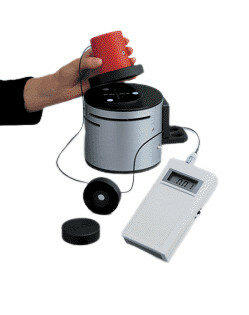Please specify the quantity of product(s).







Ugo Basile Thermal Plantar

Automatic measurement of hyperalgesia to thermal stimulation in unrestrained animals.
- Computer compatibility: direct connection to a PC, via the dedicated software included as standard
- PC Interface: USB and serial
- Read-out: multifunction liquid-crystal graphic-display
- Data Portability: via the Memory-Key provided with the standard package
- Print-out: by optional thermal mini-printer
- Universal Mains85-264 VAC, 50-60Hz
- Automatic detectionof the behavioural end point
- Validityunaffected by repeated testing
- Greater bioassay sensitivitythan other thermal or mechanical tests
- Each animalcan serve as its own control
- Starting: via keys on the I.R. Vessel.
- I.R. Intensity: adjustable in the interval 10-99 (in one digit steps)
- Reaction Time: three-digit LED display, 0.1s steps
- Calibration: via I.R. Radiometer
| Physical | |
| Dimensions (assembled) | 85 x 40 x 35 cm |
| Weight | 13.00 Kg |
| Shipping Weight | 27.50 Kg approx. |

Determination of acute nociceptive thermal threshold in laboratory animals has primarily relied upon the tail flick and hot plate methods. Although both methods are used frequently in pharmacological studies, they are not without limitation. In addition, neither method has been extended to investigating behavioural responses to hyperalgesia.
The Plantar Test represents a remarkable advance in methodology, as it combines the best features of all other methods of measuring pain sensitivity. Unique to the Plantar Test, the animal is unrestrained and unhandled during experiments.
The Instrument basically consists of:
- A Movable I.R. (infra-red) Source
- A Glass Pane bench for which the animal enclosure is located
- A Controller
- Multiple Configuration Animal Enclosure (3-12 Animals). Convenient for both rats and mice.
After the acclimation period, the I.R. source placed under the glass floor (see the picture) is positioned by the operator directly beneath the hind paw. A trial is commenced by depressing a key.
When the rat feels pain and withdraws its paw, the I.R. source switches off and the reaction time counter stops. The withdrawal latency to the nearest 0.1 s is automati-cally determined.
DATA AQUISITION
This model has a microprocessor controlled unit. The experimental data, stored in its internal memory can be directly exported to the PC USB or serial ports.
Communication is managed by the dedicated CUB Data Acquisition Software Package, included as standard or by the Win-DAS Software.
The CUB Windows®-based Software Package enables the user to route the experimental data to the PC and store them into individual files, to be managed by most statistical analysis packages available on the market.
The model is provided with a memory key, to record all the experimental data of one or more sessions and to program the experiment layouts from a remote PC.
CALIBRATION RADIOMETER
Each Plantar Test Unit is accurately calibrated via an Heat-Flow I.R. Radiometer.
The end user should consider this extremely useful accessory, which enables the experimenter to:
- Make sure that two or more units deliver thermal nocicep-tive stimuli (expressed in mW per square cm) of exactly the same intensity.
- Know the I.R. energy (1 mW for the duration of 1s corresponds to 1 mJ) in absolute terms

